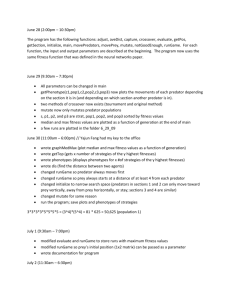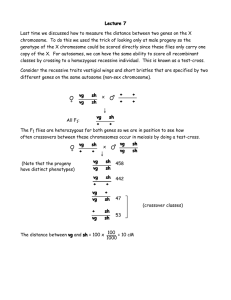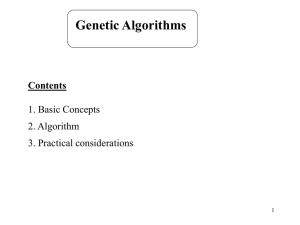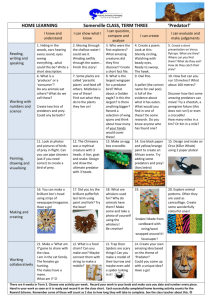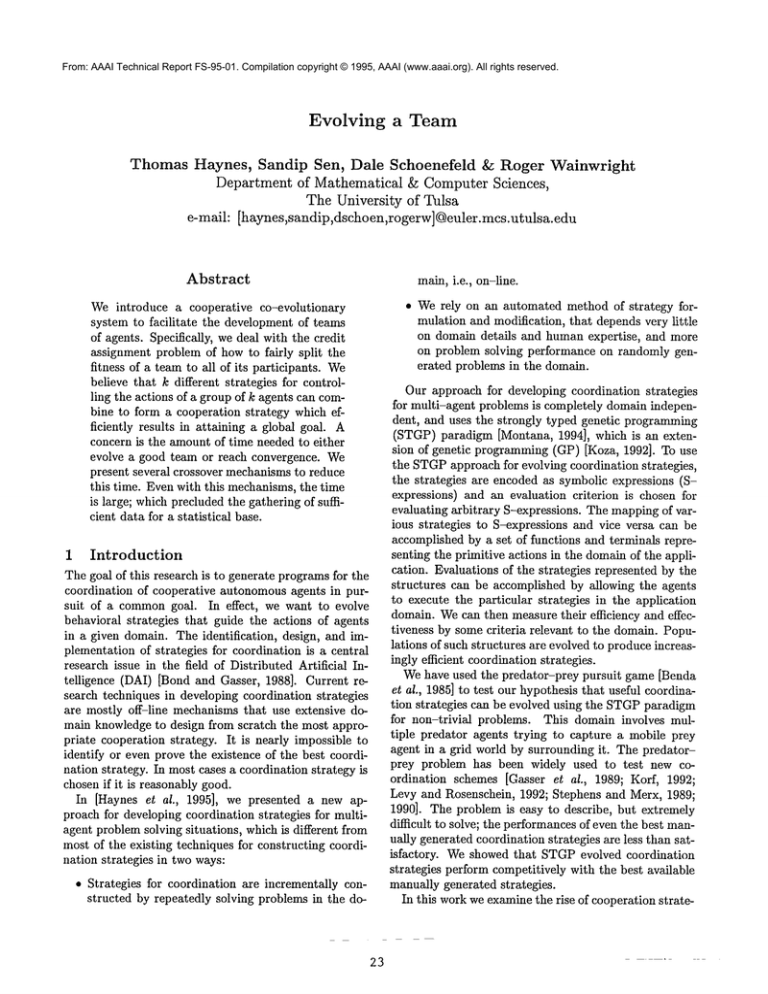
From: AAAI Technical Report FS-95-01. Compilation copyright © 1995, AAAI (www.aaai.org). All rights reserved.
Evolving
Thomas
a Team
Haynes,
Sandip
Sen, Dale Schoenefeld
&= Roger
Department
of Mathematical
& Computer Sciences,
The University
of Tulsa
e-mail: [haynes,sandip,dschoen,rogerw]@euler.mcs.utulsa.edu
Abstract
Wainwright
main, i.e., on-line.
¯ Werely on an automated method of strategy formulation and modification, that depends very little
on domain details and human expertise, and more
on problem solving performance on randomly generated problems in the domain.
Weintroduce a cooperative co-evolutionary
system to facilitate
the development of teams
of agents. Specifically, we deal with the credit
assignment problem of how to fairly split the
fitness of a team to all of its participants. We
believe that k different strategies for controlling the actions of a group of k agents can combine to form a cooperation strategy which efficiently results in attaining a global goal. A
concern is the amount of time needed to either
evolve a good team or reach convergence. We
present several crossover mechanismsto reduce
this time. Even with this mechanisms, the time
is large; whichprecluded the gathering of sufficient data for a statistical base.
1
Introduction
The goal of this research is to generate programsfor the
coordination of cooperative autonomous agents in pursuit of a commongoal. In effect, we want to evolve
behavioral strategies that guide the actions of agents
in a given domain. The identification,
design, and implementation of strategies for coordination is a central
research issue in the field of Distributed Artificial Intelligence (DAI) [Bond and Gasser, 1988]. Current research techniques in developing coordination strategies
are mostly off-line mechanisms that use extensive domain knowledge to design from scratch the most appropriate cooperation strategy. It is nearly impossible to
identify or even prove the existence of the best coordination strategy. In most cases a coordination strategy is
chosen if it is reasonably good.
In [Haynes et al., 1995], we presented a new approach for developing coordination strategies for multiagent problem solving situations, which is different from
most of the existing techniques for constructing coordination strategies in two ways:
¯ Strategies for coordination are incrementally constructed by repeatedly solving problems in the do-
23
Our approach for developing coordination strategies
for multi-agent problems is completely domain independent, and uses the strongly typed genetic programming
(STGP) paradigm [Montana, 1994], which is an extension of genetic programming (GP) [Koza, 1992]. To use
the STGPapproach for evolving coordination strategies,
the strategies are encoded as symbolic expressions (Sexpressions) and an evaluation criterion is chosen for
evaluating arbitrary S--expressions. The mappingof various strategies to S-expressions and vice versa can be
accomplished by a set of functions and terminals representing the primitive actions in the domainof the application. Evaluations of the strategies represented by the
structures can be accomplished by allowing the agents
to execute the particular strategies in the application
domain. Wecan then measure their efficiency and effectiveness by some criteria relevant to the domain. Populations of such structures are evolved to produce increasingly efficient coordination strategies.
Wehave used the predator-prey pursuit game [Benda
et al., 1985] to test our hypothesis that useful coordination strategies can be evolved using the STGPparadigm
for non-trivial
problems. This domain involves multiple predator agents trying to capture a mobile prey
agent in a grid world by surrounding it. The predatorprey problem has been widely used to test new coordination schemes [Gasser et aI., 1989; Korf, 1992;
Levy and Rosenschein, 1992; Stephens and Merx, 1989;
1990]. The problem is easy to describe, but extremely
difficult to solve; the performancesof even the best manually generated coordination strategies are less than satisfactory.
We showed that STGPevolved coordination
strategies perform competitively with the best available
manually generated strategies.
In this work we examinethe rise of cooperation strate-
gies without implicit communication. In our previous
research, the developed strategies had implicit communieation in that the same program was used to control
the four predator agents. This removal of implicit communication is achieved by having each predator agent
being controlled by its own program. Such a system
solves a cooperative co-evolution problem as opposed
to a competitive cod-evolution problem as described
in [Angeline and Pollack, 1993; Haynes and Sen, 1995;
Reynolds, 1994]. We believe that cooperative codevolution provides opportunities to produce solutions to
problems that cannot be solved with implicit communication.
The rest of this paper is laid out as follows: Section 2
introduces the pursuit domain, and describes the experimental setup. Section 3 presents three crossover strategies, beyond simple point based crossover, for improving
the learning of the team. Section 4 shows the relevance
of this work to current research topics in GP. Section 5
comparesthe utility of several of the crossover strategies
as they evolve teams. Section 6 wraps up our research
into team formation. Section 7 points out how this work
can be extended.
2
Pursuit
Domain
In our experiments, the initial configuration consisted
of the prey in the center of a 30 by 30 grid, and the
predators are placed in random non-overlapping positions. All agents choose their action simultaneously. For
the training cases, each team is allowed 100 moves per
case. The environment is updated after all of the agents
move, and the agents choose their next action based on
the updated state. Conflict resolution is necessary since
we do not allow two agents to co-occupy a position. If
two agents try to move into the same location simultaneously, they are "bumped back" to their prior positions. One predator, however, can push another predator (but not the prey) if the latter decided not to move.
The prey’s movementsare controlled by a strategy that
moves it away from the nearest predator, with all ties
being non-deterministically
broken. The prey does not
move10%of the time: this effectively makes the predators travel faster than the prey. The grid is toroidal in
nature, and diagonal moves are not allowed. A capture
is defined as all four predator agents occupying the cells
directly adjacent, and orthogonal, to the prey, i.e., when
the predators block all the legal movesof the prey.
A predator can see the prey, and the prey can see
all the predators. Furthermore, two predators cannot
communicateto resolve conflicts or negotiate a capture
strategy. These two rules eliminate explicit communication between agents.
2.1
Evaluation of Coordination
for Predators
Strategies
To evolve coordination strategies for the predators using
STGPwe need to rate the effectiveness of those strategies represented as programs or S-expressions. Wechose
to evaluate such strategies by putting them to task on
k randomly generated pursuit scenarios. For each scenario, a program is run for 100 time steps. The percentage of capture is used as a measure of fitness when we
are comparing several strategies over the same scenario.
Since the initial population of strategies are randomly
generated, it is very unlikely that any of these strategies will produce a capture. Thus we need additional
terms in the fitness function to differentially evaluate
these non-capture strategies. The key aspect of STGPs
or GAsis that even though a particular structure is not
effective, it maycontain useful substructures which when
combined with other useful substructures, will produce a
highly effective structure. The evaluation (fitness) function should be designed such that useful sub-structures
are assigned due credit.
With the above analysis in mind, we designed our evaluation function of the programs controlling the predators
to contain the following terms:
¯ After each moveis made according to the strategy,
the fitness of the program representing the strategy is incremented by (Grid width) / (Distance
predator from prey), for each predator. Thus higher
fitness values result from strategies that bring the
predators closer to the prey, and keep them near the
prey. This term favors programs which produce a
capture in the least number of moves.
¯ Whena simulation ends, for each predator occupying a location adjacent to the prey, a number equal
to (number of moves allowed ¯ grid width) is added
to the fitness of the program. This term is used to
favor situations where one or more predators surround the prey.
¯ Finally, ira simulation ends in a capture position, an
additional reward of (4 * number of moves allowed
¯ grid width) is added to the fitness of the program.
This term strongly biases the evolutionary search
toward programs that enable predators to maintain
their positions when they succeed in capturing a
prey.
In our experiments, the distance between agents is
measured by the Manhattan distance (sum of x and
offsets) between their locations. Wehave limited the
simulation to 100 time steps. As this is increased, the
capture rate will increase.
In order to generate general solutions, (i.e., solutions
that are not dependent on initial predator-prey configuration), the same k training cases were run for each
memberof the population per generation. The fitness
measure becomesan average of the training cases. These
training cases can be either the same throughout all generations or randomly generated for each generation. In
our experiments, we used random training cases per generation.
3
Establishing
Teamwork
an Environment
successfully co-evolve a set of prototypes for supervised
concept classification problems [Knight and Sen, 1995].
3.1
TeamBranch
for
In our earlier work, each program was represented as a
chromosome in a population of individuals.
The members of a team can randomly be selected from the population of chromosomes, with each member awarded a
certain percentage of the total fitness. 1 Each member
wouldget the points that it definitely contributed to the
team’s fitness score. Howdo we divide up the team’s
score among the participating
members (chromosomes)?
Is it fair to evenly divide the score? Assumingk members
to a team, if the actions of one individual accounted for
a large share of the team’s score, whyshould it only get
lth of the score? This problem is the same as the credit
assignment problem in [Grefenstette, 1988]. A modification of this strategy is to deterministically split the
population into k sized teams. Thus the first k individuals would always form the first team. The problem with
this is that it imposesan artificial ordering on the population. The same team in generation Gi might not be
formed in generation Gi+l due to a re-ordering caused
by the reproductive cycle.
The method we employ to ensure consistency of membership of a team is to evolve a team rather than an
individual. Thus each chromosome consists of k programs. Subject to the effects of crossover and mutation, we are ensured that the same members will form
a team. This effectively removes the credit assignment
problem. Each team memberalways participates in the
same team. Thus all of the points it is awarded, for both
its individual contribution and the teams contribution,
are correctly apportioned to the entire team.
This approach is similar to "the Pitt approach"
used for evolving Genetic-Based Machine Learning systems [DeJong, 1990]. For GAbased production systems,
there are two camps as how to maintain a ruleset: the
Pitt approach is to maintain the entire ruleset as an individual string with the entire population being a collection of rulesets, and "the Michigan approach" is to
maintain the entire population as the ruleset. In the
Michigan approach there is the credit assignment problem of how to correctly award individual rules for their
contributions to the global solution. The Pitt approach
bypasses the credit assignment problem, in that rules
are only evaluated in the context of a ruleset. A similar
mechanism as proposed in this paper has been used to
1Wecould also ensure that each memberof the population
participates in ~ teams.
25
(b}
(0
Figure 1: Example crossover for 1 crossover point in a
chromosome.
Our method of maintaining consistency in a team does
introduce a problem in that what do we do for crossover?
Do we allow crossover, as shown in Figure 1, to take
place in the usual sense? (i.e. only one of the programs participates in the crossover.) Or, as shown in
Figure 2, do we allow all of the programs to participate
in crossover? The first crossover mechanismallows only
relatively small changes of parent structures to produce
offspring, and thus slows downlearning.
3.2
TeamAll
,;
/ ]
/i
1
4
°oii
I
Figure 2: Examplecrossover for all programsin a tree. A
crossover point is selected in the subtree of each program.
Thus there are four crossovers taking place; between each
program P~ for the two chromosomes.
The second crossover mechanismwill speed up the emergence of good cooperation strategies by allowing each
program in a parent structure to participate
in the
crossover process. A research issue in this crossover
method is determining whether we should constrain
crossover between corresponding programs in the two
parents. If the first programin the first parent always
crosses over with the first program in the second parent,
then can the first program become a specialist? There
can be a need for specialists, i.e. the dessert maker in
a team of cooks, but in applying this constraint do we
restrict ourselves to a part of the solution space in which
the global optimum can not be found?
Somepossible solutions to this concern are:
1. For chromosomes A and B, randomly determine
which program Ai will be used in crossover with
program Bj. Also each program in a chromosome
participates exactly once in the crossover process.
(o
2. A new mutation operator could be defined which
swaps subtrees between programs in a chromosome.
This is different than recombination in that there is
only one "parent" and one resultant "child".
3.3
TeamUniform
A third crossover mechanism is to adapt the uniform
crossover function from GAresearch. Basically we would
develop a uniform crossover mask for the programs inside
a chromosome. A "r’ would indicate that the programs
are copied into the respective child, while a "0" would
indicate that the programs would undergo crossover. We
are able to use the uniform crossover function because
the number of programs in a team is fixed. Since the
programs are not atomic in the sense that alleles in GAs
are, we could randomly determine the interactions between the programs. An example of this is if we decided
that the order of interaction between two parent chromosomesi and j is i(3241) and j(4123), and the
mask is {1001}, then this would produce the children
s(3(2X1)(4X2)l and t(4(2X1)(4X2)3. This is represented visually in Figure 3. The programs have been
re-ordered such that i3 is paired with j4, etc.
3.4
TeamKCross
A fourth crossover function is to allow k crossover points
inside a chromosome. A restriction
is that crossover
point i can not be an ancestor node of any crossover
point j, j ~ i. A difference between this methodand the
previous methods is that two crossovers can happen to
the same program, as can be seen in Figure 4. Each
crossover point i is not tied to any one program.
4
Implications
Figure 3: Example uniform crossover for the mask
(1001). (a) has Parent i with aa ordering of (3241).
has Parent j with an ordering of (4123). (c) has Child
with two children created via crossover. (d) has Child
with two children created via crossover.
While Koza’s Automatically
Defined Functions
(ADF)[Koza, 1994] are not separate "agents", they utilize manydifferent branches, say k, to facilitate learning. In the GPmailing list, Siegel [Siegel, 1994] posed
the question as to whether some form of crossover utilizing k > 1 would help in the learning process? The
replies were mixed, and pointed out the need for further
research.
5 Results
Wehave tested two different approaches to constructing
teams for the predator agents: TeamBraach,Section 3.1,
each team memberhas its own program, i.e. subtree,
of Research
{3rtmv~Pdr~.
There has been previous research into S-expressions containing more than one executable branch. Both Andre [Andre, 1995] and Haynes [Haynes, 1994] have investigated systems in which one branch of the S-expression
manipulate a memory structure and the other branch
utilizes the memorystructure to interact with an environment. Andre explicitly creates two programs in
the S-expression, while Haynes relies on strong typing
to force the root node to develop two branches for the
construction and utilization of memory. Both of these
systems can be considered to utilize the Pitt approach
to credit assignment.
26
oo~" i,
¯
¯
|
i
¯
"¯
~oO
Ss
,
I
~)
Figure 4: Examplecrossover k crossover points in a chromosome.
and there is one branch crossover. TeamAll, Section 3.2,
each team memberhas its own program, i.e. subtree,
and there is k -- 4 branch crossover. Finally, we compare
the above strategies against the methodwe have utilized
in our previous research: TeamTree, each team member
shares the same program.
The basic setup for each experiment was a population size of 600, a maximumof 1000 generations, and
a maximumfitness of 48,000. Note that even if either
a good solution or convergence was found before 1000
generations, we let the system continue. In order to be
somewhatfair, we ran each approach with the same four
different initial seeds for the randomnumber generator.
Wewould have liked to have a better statistical
base,
but each run takes between four to ten days, depending
on the Sun system used.
5.1
Population
0
Figure 6:
crossover.
Average and Best Fitness
for 1 branch
Results
The averaged results for the Best and Average Fitnesses
per generation are shown in Figures 5 (TeamTree),
(TeamBranch), and 7 (TeamAll). In general the
of Generation curves have reached a plateau of about
20,000 to 22,000 fitness points. If we look at the "center"
of the plateaus, then the systems can be ranked in the
order of TeamTree, TeamAll, and TeamBranch. These
curves can also be broken into three regions, although it
is harder to do so for TeamBranch,Figure 6.
The differences occur in reaching that plateau. The
TeamTree curve learns faster than both TeamBranch
and TeamAll. It reaches both of its plateaus before
the other systems. The TeamAll system learns faster
than the TeamBranch. Notice that TeamAll reaches the
plateau level about 200 generations before TeamBranch.
Figure 5: Average and Best Fitness for no branches.
5.2
1OO0O
Team Analysis
Wehave also tested the best individuals per system for
both 1000 random test cases and the 30 standard test
cases as set forth by Stephens and Merx [Stephens and
Merx, 1989]. Each team was allowed to move for 200
time steps. None of the teams did very well.
27
Figure 7: Averageand Best Fitness for all crossover.
In Table 1, we present the results of the prey having a
move away from nearest predator (MAFNP)algorithm.
Due to space considerations, we do not present other
prey algorithms. Wedo include performance results of
agents controlled by the MN, MNO,MD, and MDOfor
comparison. The STGPalgorithm is the evolved strategy reported in [Haynes et aL, 1995], and the other algorithms are based on the max norm (MN and MNO)and
Manhattan distance (MD and MDO)algorithms.
They
are discussed in detail in [Haynes et al., 1995]. The
STGPstrategy represents the TeamTree team.
The TeamAll team did better than the TeamBranch
team, but they both did worse than the STGP algorithm. Also, from our analysis of the best four teams
per crossover system, we determined that the some of
the TeamBranch and TeamAll behavioral strategies allow the prey to escape capture. This does not happen
whenthe same strategy is used to control all agents, i.e.
STGP.
The moves taken by the STGP program (strategy)
for various relative positions of a predator with respect
to the prey are graphically represented in Figure 8. In
Figure 9, the moves taken by the four predators, from
the TeamAll strategy A1, are graphically represented.
Note that Figure 9(a) and Figure 9(b) are very simi-
Captures
STGP
0.385(0.496)
0.385(0.496)
A1
I0.308(1.995)
10.308(1.995)
B1
6.000(1.811)
6.000(1.811)
MNO
0.000(0.0O0)
0.346(0.562)
MDO
2.423(1.528)
2.423/1.528
)
MN 0.077(0.272)
2.000(1.265)
MD
15.808(2.173)
15.803(2.173)
Prey First
Steps
29.500(24.185)
29.500(24.185)
115.466(13.152)
115.466(13.152)
107.000(16.859)
107.000(16.859)
0.000(0.0O0)
104.333(94.001)
56.254(34.139)
56.254(34.139)
199.000(194.979)
112.615(53.095)
101.182(12.816)
101.182(12.316}
Blocks
5.846(2.412)
2.462(1.794)
1.692(1.123)
0.346(0.562)
13.731(3.672)
1.731(1.589)
3.231(1.394)
Captures
14.846(1.642)
14.846(1.642)
0.115(0.326)
0.115(0.326)
0.962(0.720)
0.962(0.720)
0.000(0.00O)
0.308(0.471)
2.923(1.742)
2.923/1.742
/
0.000(0.000)
0.538(0.647)
17.615(2.654)
17.615(2.654)
Prey Sync
Steps
109.412(11.872)
109.412(11.872)
99.333(98.241)
99.333(98.241)
109.160(70.818)
109.160(70.818)
0.000(0.000)
99.875(89.788)
55.263(23.194)
55.263(23.194)
0.000(0.000)
127.071(100.675)
108.919(11.340)
108.919(11.340)
Blocks
3.462(1.529)
0.577(0.809)
0.654(0.745)
0.385(0.571)
14.077(2.576)
1.385(1.098)
2.000(1.296)
Table 1: Average number of captures for MAFNP
Prey (standard deviations are presented in parentheses).
lar movementstrategies. This observation suggests that
the predator agents are learning the same behavioral
strategy, which in turn implies implicit communication
is starting to take place. A similar occurrence of this
duplication of strategies was observed in one of the four
best TeamBranch chromosomes.
6
Conclusions
Webelieve that the TeamAllstrategy for building a team
is better than the TeamBranchstrategy. In particular,
with each agent’s program engaging in crossover versus
only one of the agent’s programs engaging in crossover,
learning is faster. The TeamTreebuilding strategy fares
better than either of the other two. Webelieve that
this feature is due to the implicit communication that
the TeamTree team members have available. It is our
conjecture that the others can be evolving implicit communication in that team membersare developing similar
behavioral strategies.
Our belief that the TeamAll strategy is better than
the TeamBranchstrategy has been supported by the collected data. As we gather further data, we will see if this
is truly statistically significant.
7
Future
Work
Clearly we need to run more test cases in order to build
a statistical basis for significance testing. Wealso need
to experiment with the uniform crossover and k-point
crossover mechanismsmentioned earlier.
Weneed to develop some tools to enable us to analyze
the similarity of two chromosomes; both in semantical
and syntactical content. This is evidenced by there being two team memberswith different subtrees, but with
identical results.
8
Acknowledgments
This research was partially supported by OCASTGrant
AR2-004, NSF Research Initiative
Award IRI-9410180
and Sun Microsystems, Inc.
28
Wewould also like to thank the anonymousreviewers
for many helpful comments, in particular for the reference to the ADFdiscussion in the GPmailing list. UnaMayO’Reilly was very helpful in forwarding a copy of
the 1994 mailing list.
Figure 8: Pursuit path found by STGP.
(a)
(b)
(c)
(d)
Figure 9: Pursuit paths found by A1.
29
References
[Andre, 1995] David Andre. The evolution of
that build mental models and create simple
using genetic porgramming. In Proceedings
Sixth International
Conference on Genetic
rithms, pages 248-255, 1995.
prey. In IJCAI-95 Workshop on Adaptation
Learning in Multiagent Systems, 1995.
agents
plans
of the
Algo-
[Angeline and Pollack, 1993] Peter J. Angeline and Jordan B. Pollack. Competitive environments evolve better solutions for complex tasks. In Proceedings of
the Fifth International Conference on Genetic Algorithms, pages 264-278. Morgan KaufmannPublishers,
Inc., 1993.
[Benda et al., 1985] M. Benda, V. Jagannathan, and
R. Dodhiawalla. On optimal cooperation of knowledge sources. Technical Report BCS-G2010-28, Boeing AI Center, Boeing Computer Services, Bellevue,
WA, August 1985.
[Bond and Gasser, 1988] Alan H. Bond and Les Gasser.
Readings in Distributed Artificial Intelligence. Morgan
Kaufmann Publishers, San Mateo, CA, 1988.
[DeJong, 1990] Kenneth A. DeJong. Genetic-algorithmbased learning. In Y. Kodratoff and R.S. Michalski,
editors, Machine Learning, Volume III. Morgan Kaufmann, Los Alamos, CA, 1990.
and
[Haynes et al., 1995] Thomas Haynes, Roger Wainwright, Sandip Sen, and Dale Schoenefeld. Strongly
typed genetic programming in evolving cooperation
strategies. In Proceedings of the Sixth International
Conference on Genetic Algorithms, pages 271-278,
1995.
[Haynes, 1994] Thomas D. Haynes. A simulation of
adaptive agents in a hostile environment. Master’s
thesis, University of Tulsa, Tulsa, OK., April 1994.
[Knight and Sen, 1995] Leslie Knight and Sandip Sen.
Please: A prototype learning system using genetic algorithms. In Proceedings of the Sixth International
Conference on Genetic Algorithms, pages 429-435,
1995.
[Korf, 1992] Richard E. Korf. A simple solution to pursuit games. In Working Papers of the 11th International Workshopon Distributed Artificial Intelligence,
pages 183-194, February 1992.
[Koza, 1992] John R. Koza. Genetic Programming: On
the Programming of Computers by Means of Natural
Selection. MITPress, 1992.
[Koza, 1994] John R. Koza. Genetic Programming II,
Automatic Discovery of Reusable Programs. MIT
Press, 1994.
[Levy and Rosenschein, 1992] Ran Levy and Jeffrey S.
Resenschein. A game theoretic approach to the pursuit problem. In Working Papers of the 11th International Workshopon Distributed Artificial Intelligence,
pages 195-213, February 1992.
[Montana, 1994] David J. Montana. Strongly typed genetic programming. Technical Report 7866, Bolt Beranek and Newman,Inc., March 25, 1994.
[Reynolds, 1994] Craig W. Reynolds. Competition, coevolution and the game of tag. In Artificial Life IV.
MIT Press, 1994.
[Gasser et al., 1989] Les Gasser, Nicolas Reuquette,
Randall W. Hill, and John Lieb. Representing and
using organizational knowledge in DAI systems. In
Les Gasser and Michael N. Huhns, editors, Distributed
Artificial Intelligence, volume2 of Research Notes in
Artificial Intelligence, pages 55-78. Pitman, 1989.
[Siegel, 1994] Eric Siegel. ADFCrossover - response
summary. Genetic Programming Mailing List, June
15th 1994.
[Stephens and Merx, 1989] Larry M. Stephens and
Matthias B. Merx. Agent organization as an effector of DAI system performance. In Working Papers
of the 9th International Workshop on Distributed Artificial Intelligence, September1989.
[Grefenstette, 1988] John Grefenstette. Credit assignment in rule discovery systems. Machine Learning,
3(2/3):225-246, 1988.
[Stephens and Merx, 1990] Larry M. Stephens and
Matthias B. Merx. The effect of agent control strategy on the performance of a DAI pursuit problem. In
Proceedings of the 1990 Distributed AI Workshop, October 1990.
[Haynes and Sen, 1995] Thomas Haynes and Sandip
Sen. Evolving behavioral strategies in predators and
3O

